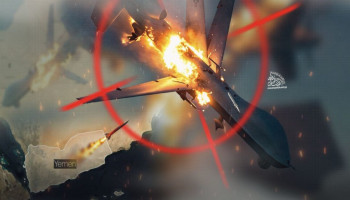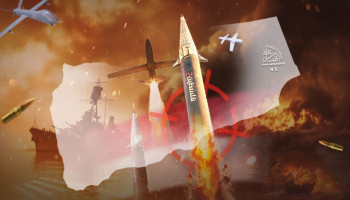In a recent address, the leader of Yemen, Sayyid Abdulmalik Badreddin al-Houthi, announced the commencement of the fourth phase of military operations. This phase is dedicated to supporting the Palestinian people as long as the American and Israeli enemies continue to violate the rights of the people in Gaza. The Yemeni leader has pledged not to leave the battlefield until Allah grants victory.
The Yemeni armed forces have revealed their upcoming operations as part of the fourth phase of escalation. The essence of this phase is to complete the imposition of a naval blockade on all ports occupied by the Israeli entity. The armed forces’ statement included the commencement of targeting any ship arriving at the occupied Palestinian ports starting from the announcement of the statement on May 3rd.
In case the Israeli enemy contemplates invading the city of Rafah, there will be a larger escalation involving the targeting of all ships belonging to any company that supplies the Israeli entity, regardless of its nationality. The targeting will not be limited to ships that unload their cargo in the Israeli entity, but every ship associated with that company that has implicated one of its ships in supplying the Israeli entity with supplies.
The armed forces clarified that they are following the developments of the battle in the Gaza Strip due to the continued Israeli and American aggression and the preparation to carry out an aggressive military operation targeting the Rafah region. They are also following the offer made to the resistance, in which the enemy wants to snatch the card of the prisoners without a permanent ceasefire.
The armed forces reiterated that they will not hesitate to prepare and be ready for wider and stronger escalation stages until the aggression stops and the blockade is lifted from the oppressed Palestinian people in the Gaza Strip.
Targeting 107 Ships
The failure of the United States is confirmed by the escalating statistics of Yemeni naval operations. The leader of the revolution, Sayyid Abdulmalik Badreddin al-Houthi, revealed in his last speech that the number of ships associated with the enemy that were targeted reached 107 ships. The armed forces carried out eight operations last week in the Gulf of Aden and the Arabian Sea, reaching the Indian Ocean, and southern Palestine. The eight operations were carried out with 33 ballistic and winged missiles, in addition to drones, during which six ships associated with the Israeli, American, and British enemies were targeted. An American reconnaissance aircraft of the type (MQ9) was also shot down in the skies of Saada, which is the third during this period.
The leader added that the total operations carried out since the beginning of the Battle of Al-Aqsa Flood reached 156 operations in the sea and southern occupied Palestine. The operations against the ships were carried out with 606 ballistic and winged missiles, and drones since the beginning of the Al-Aqsa Flood. He confirmed that the armed forces bombed enemy targets in occupied Palestine 111 times, with the use of ballistic missiles, winged missiles and drones.
This large number clearly proves that the United States and its allies have not been able to even form a barrier against the escalating pace of Yemeni naval operations, let alone stop or limit them. This means that the Yemeni armed forces have succeeded exceptionally in imposing an equation to ban ships associated with the Zionist entity, the United States, and Britain. The renewal of American defensive ammunition will not make any difference and will only add more financial losses to the account of American failure.
On April 29, a battle took place in the Indian Ocean, through which the Yemeni armed forces were able to force America and Britain to acknowledge the ability of the Yemeni army to accurately target ships in the Indian Ocean in light of the Western inability to change the equation proposed by the Yemeni army.
In the details, the qualitative operation began by launching several drones at two American warships. A joint operation was also carried out by the naval forces, the missile force, and the drone air force, during which the ship (CYCLADES) was targeted in the Red Sea. The ship was targeted after violating the decision to ban the passage of ships heading to the occupied Palestinian ports by heading to the port of Umm al-Rashrash on April 21st in a deceptive and misleading manner by claiming to head to another port. However, it was under the surveillance and follow-up of our armed forces, and warnings were issued to it not to enter the occupied Palestinian ports. It insisted on violating the ban decision, so it became on the list of targeted ships and those prohibited from sailing in the area of operations of the Yemeni armed forces.
Despite the enormity of the previous operation, which proved the ability of the Yemeni army to fully control the theater of operations based on accurate intelligence information, the other part of the armed forces’ statement was the most impactful on the evil trio (America, Britain, “Israel”). It included the announcement of targeting the Israeli ship (MSC ORION) in the Indian Ocean.
[playlist type="video" ids="672262"]
Western Concern About Losing Control in the Indian Ocean
As soon as the Yemeni armed forces announced the targeting of the Israeli ship (MSC ORION) in the Indian Ocean, officials in America and Britain rushed to express their concern about the operation. The American maritime trade website “Maritime Exclusive” mentioned that the details of the attack on the ship were confirmed by the maritime security forces in the region and that the attack on the MSC Orion ship in the Indian Ocean raises concern because the ship was a great distance from Yemen and the operation indicates that the Yemenis have expanded the range of their drones.
Organizations of maritime trade in the United Kingdom and the Joint Maritime Information Center conveyed the details of the attack on the ship “MSC Orion” which took place on the night of April 29-30. According to JMIC, the ship was in the Indian Ocean about 300 nautical miles east-southeast of the country, or more than 170 nautical miles south of Socotra Island. The British Maritime Trade Authority “UKMTO” located the ship 400 nautical miles from the mainland of Yemen.
The targeted ship, registered in Portugal and owned by Israeli billionaire Eyal Ofer, and leased to MSC, reported an explosion and found some debris believed to be from an “unmanned air system”. Adding that it suffered some minor damage with a report coming in that the crew was not harmed and that the ship was on its way to Salalah in Oman before closing its identification device.
The American site referred to the threat of the Yemeni armed forces in mid-March, to expand the attack area to include parts of the Indian Ocean, and that they will target ships that try to move away from the Red Sea and travel around Africa. Adding: So far, despite the occurrence of many other attacks in the Indian Ocean, this is the first time that these attacks have been confirmed at these distances.
It explained that in the past, for example, the tanker Marlin Luanda was about 60 miles from Aden when it was hit. The ship was hit by a missile in January, which caused a fire, while the bulk ship “True Confidence” was about 50 miles from the shore when it was attacked, resulting in the death of three crew members.
The Associated Press agency said that the attack on the MSC ship in the Indian Ocean immediately raised questions about how the “Houthis” were able to carry out an attack hundreds of kilometers from the shores of Yemen on a moving target. The maritime executive site said that the incident raises worrying questions because the ship was much further away from Yemen, which may indicate that the Houthis have expanded the range of their drones.
US Marines Learning from Yemeni Tactics
The Marine Corps Times, a newspaper concerned with US Navy news, reported that the US Marines are learning from Yemeni tactics in the Red Sea. The Yemenis identify ship locations, launch drones and missiles at them, and then move to another location, making it difficult to track them. The Yemenis have shown that a land force equipped with sensors and missiles can pose significant challenges to ships.
The Marine Corps Times explained that the Yemenis have quickly developed their efforts into an excellent example of how to conduct effective reconnaissance, counter-reconnaissance, and prevent sea entry during confrontations. They added that the Houthis have imposed costs on the powerful navy by tracking ships, threatening them with drones and missiles, and disrupting travel through vital waterways while they are near the coast.
The site quoted Bryan Clark, a researcher at the Hudson Institute, saying that it is difficult to track the Yemeni forces attacking the ships. From within Yemeni territory, they can identify ship locations, launch drones and anti-ship missiles at these ships, and then move to another location, making it difficult to track them. The United States cannot stop these attacks unless it carries out very aggressive and continuous actions in addition to engaging in continuous and comprehensive surveillance.
Clark said, “Although the Houthis lack some of the capabilities of the Marines in electronic warfare, I believe this is an example of the kind of operation that the Marines are trying to carry out and the Yemenis have done so very effectively using a force much less advanced than that of the US Navy.”
The article pointed out that the US Navy now has new concepts about the possibility of paralyzing the enemy’s naval capability through trained land forces with accurate information and missiles and sensors.
Lieutenant Colonel Travis Hurd, a student at the college, said that as part of the “Force Design” program, which lasts for 4 years to develop the US Marines to be able to face a navy with China, the tactics executed by the Yemenis in the sea against us reveal that the US Navy can do the same thing when clashing with an opponent like China. While the belief was that the US Navy could not carry out distributed operations within the weapons clash area for an opponent like China, I believe that what the Yemenis show is that they may be able to do so, because they have been able to do so against us to some extent.
From Hurd’s point of view, “the operations and tactics of the Yemenis cannot be considered an absolute confirmation to rely on and build on in the Force Design program, yet the Yemeni tactics have revealed to us that a land force equipped with sensors and missiles can pose significant challenges to ships.”
Retired Colonel TX Hams, who is a senior researcher at the National Defense University, said that one of the lessons learned from the fighting between the Yemenis and the US Navy is that warships can only withstand a small number of missiles, not a large number, and therefore the Marines must have more of these ships.
The Marine Corps team confirmed in this article that the US Marines have allocated a team of them to study the combat operations in the Red Sea and the Gulf of Aden.
The article added that in a 2021 document explaining the reserve forces, which is a concept that envisions the presence of Marines near the opponent to conduct reconnaissance and support naval missions, the Corps allocated a page for Houthi activities, in the period from 2016 to 2018 in the Red Sea.
According to this document, Yemeni naval capabilities “have quickly developed their efforts into an excellent example of how to conduct effective reconnaissance, counter-reconnaissance, and prevent sea entry while working in a disputed area.”
The article added that "the Houthis are not the only hostile parties that the US Army can learn from.
Richard Weitz, director of the American Hudson Institute for Military Analysis, said that the issue of defeating those he described as “Houthis” is a difficult matter because they believe that Allah stands with them and this explains their success for years against stronger forces than them previously and now with Western countries.
Weitz explained in an interview with him on the American “Alhurra” channel, that the “Houthis” have greater incentives than others to attack Western targets and cannot be prevented or controlled.
What is happening in the Red Sea is a farce
American confessions of failure in the face of Yemeni qualitative strikes and that the American navy has become helpless in the face of advanced Yemeni weapons continue. A few days ago, a number of members of the US Senate criticized Washington’s role in confronting Yemeni naval attacks in the Red Sea, describing what is happening as a “farce in plain terms,” and said: “For months now, we have been in the Red Sea in an unenviable position…”.
US Navy Secretary Del Toro said during a “Congress” hearing session: “Our forces have engaged in 200 clashes with missiles and drones launched from Yemen,” adding: “Shots were fired directly at our ships and sailors all over the Red Sea, and unfortunately, we lost 3 of our special forces.”
For her part, Admiral Lisa Franchetti, the head of naval operations, confirmed during the same hearing session that “the threat from Yemen is large and very difficult.”
For his part, Mike Rogers, chairman of the House Armed Services Committee, explained that “the navy is carrying out operations at a much faster pace than planned, as it consumes missiles quickly, burns fuel, and extends deployment periods while defending in the Red Sea and protecting Israel.”
US Senator Dan Sullivan, in the hearing session, commented on the withdrawal of the aircraft carrier from the Red Sea, saying: “The aircraft carrier (USS Dwight Eisenhower) and with it a warship left the Red Sea chased by Yemen.”
Senator Tim Kaine, who chaired a hearing session for the Armed Forces Committee in the US Senate on the US Marines, said: “Our forces face threats daily in the Red Sea. Those one or two missiles, or one or two drones, or one or two USVs are out there waiting for our people and for our systems to slip up." He continued: “No one in this room would deny the difficult trade-offs between cost, schedule, and performance that our requirement officers and program managers work through every single day; but the Red Sea has to remind us all how well we balance those trade-offs, which ends up being measured in very concrete ways in times of crises.”
He added: “For months now in the Red Sea, we have been in a position where we have to succeed 100% of the time, not 99%, not 98%, with our sailors, many from Virginia, in Harm’s way; those connected to the enterprise and others in that strike group and Harm’s way, we have to succeed 100% of the time.” He said: “A weapon system that delivers too late, or is too expensive to afford, or is not mission-capable when it needs to be, is not doing anything for sailors and marines as they go into harm’s way."
He continued: “Getting these trade-offs wrong will also consume taxpayer dollars that could buy real-time capability elsewhere," he said: “We bear the responsibility to preserve the safety of our members. Despite the best efforts of all predecessors, we have watched as the performance of Navy shipbuilding slowly declined, and this is something I know we are going to talk a lot about today, and we know that the pacing threat for the Navy and the Marine Corps is even more stressing ultimately than the challenge that we face in the Red Sea.”
Kaine considered that it is time to pay the bills to update strategic capabilities, rebuild the infrastructure for maintaining nuclear ships due to negligence during the pandemic. Major programs such as the Columbia program face difficulty in securing a constant priority, as do secondary but very important programs. He added: “There are success stories. The production of amphibious warships and destroyer production are both moving forward at a pace, but even these programs face pretty severe workforce shortages. As the saying goes, the first step is admitting we have a challenge, admitting we have a problem.”
In the session, Senator Angus King raised questions about the decline in the energy budget in the US Department of Defense by 50% over the past two years, and said: “We spend 4 million dollars to shoot down a drone worth 20 thousand dollars from the Houthis!”. He said: “What happened to you to reduce the budget? Who thinks this is logical?.. The navy’s directed energy budget has practically dropped to zero. I can’t comprehend that!”.
He added: “We have come to live in a world of drones and low-cost missiles. This is the technology that must be of utmost priority. Instead of reducing the budget to half, it should be doubled or even tripled.”
Addressing Gertin, he said: “Can you give me any logical reason for not pursuing this vital technology as we approach the era of drone swarms?.. We cannot shoot down swarms of drones in any other way. Is there any answer to this?”
Senator King confirmed that “what is happening is a farce in plain terms,” and said: “I have been talking about this for 3 or 4 years to no avail. We are incurring severe losses and are being embarrassed in the Red Sea, and the Ukrainians are being humiliated by low-cost Iranian drones, and we are now reducing the budget for the technology that could have saved us. Do those responsible for the battles in the fleet understand the seriousness of this situation?”
Yemen Attacks Are Complex
In the same context, Avril Haines, the Director of National Intelligence, said in a hearing session for intelligence leaders before the US Senate Armed Services Committee, “As of last week, the Houthis resumed their near-daily attacks after announcing last month that they intend to escalate the strikes to include the Indian Ocean.”
In an unprecedented acknowledgment by a senior US official, acknowledging that the Yemeni armed forces produce their own weapons, Haines said: “Our assessment is that the attacks will remain active for some time, for a number of reasons including that the Houthis continue to produce a decent amount of drones locally and other weapons systems.” She added, “Our strikes were not enough to prevent the Houthis from continuing their operations.”
Haines said, “One of the things that were challenging is that they have logical justifications, and their attacks have changed over time a little and have become more complicated in some cases, they said they will not stop unless aid is delivered to Gaza, and it seems that there are additional requirements but that does not mean they will not stop if there is a ceasefire.”
Yemeni Naval School
In mid-April, a report by the American site “War on the Rocks” discussed how the Yemeni navy could be in its naval operations against Israeli, American, and British cargo ships, presenting to the world a new and modern school in naval wars different from the known traditional war school. The report, written by “Kevin D. McCranie,” a professor of comparative strategy at the American Naval War College, indicates that the Yemeni experience reveals that the matter of control over the seas is no longer limited to who owns the largest navy, and that a group of very small ships capable of carrying one torpedo can pose the biggest threat to giant warships owned by the great powers, led by the United States, and this is what we are witnessing today in the Red Sea, for example.
The report says that the Yemeni forces, repeat the experience of followers of the French school of Jean École ineffective and inexpensive naval wars in the face of large fleets, which appeared, meaning the school, at the end of the eighteenth century and the beginning of the nineteenth century during the naval military conflict between France, which did not own a navy, and Britain, the owner of the largest navy in the world at the time. The school of “Jean École” assumed that France could confront the British navy by using small, inexpensive ships not exceeding 200,000 pounds with the installation of a torpedo on them and a small number of sailors not exceeding 12 individuals, a small, inexpensive ship loaded with one torpedo and 12 sailors can sink a giant warship that cost millions of pounds at that time and carries a crew of 600 individuals.
However, the debate continued at the beginning of the twentieth century about the effectiveness of this military theory in naval wars, while Britain defended the capabilities of its navy, the followers of the school of Jean École defended their theory that it is militarily effective and that weak and poor armies can defeat the strongest navies in the world using this theory, but no experiments occurred on the ground to measure the validity or invalidity of what the school of Jean École brought.
In this report monitored by the Arabic website “Al-Masaa Press,” the American site indicates that the ongoing war between the Yemeni Navy and the American Navy and those with it in the Red Sea and the Gulf of Aden, represents an opportunity to study it in order to know the extent of the impact of changing modern technological techniques and their impact on the nature of naval wars between a weak naval force but it owns what hurts the enemy and another traditional naval force that owns a fleet of expensive destroyers.
Here, the professor at the American Naval War College describes the experience and the way the Yemenis came in their naval war with the United States and Britain, which was represented in their use of different types of relatively inexpensive weapon technologies including air and sea drones in addition to cruise missiles and ballistic missiles to attack warships and commercial ships around the southern entrance to the Red Sea, he describes it by saying: “It can be said that the Houthis add a modern touch to the methods of the school of Jean École.”
In the same context, a report by the Canadian Institute for Global Affairs revealed that the Yemeni experience revealed weaknesses in Western naval defense systems, exposed to low-cost ballistic missiles and drones and aircraft.
The Canadian report indicates that China and Russia may benefit from the Yemeni experience in developing their own naval defense systems.
The report concludes that the failure of the coalition led by the United States has significant effects on the balance of power in the region, and that the Yemeni experience has shed light on the limitations of Western military power.
Yemen is Bolder Against the West
Dr. Michael Knights, the leading researcher at the Washington Institute and a specialist in military and security affairs for Iraq, Iran, Yemen, and the Gulf countries, published a study on the war effort of the Yemeni forces since October 7, 2023.
The American researcher, who published his study in the quarterly “Counterterrorism Center,” concluded that the Ansar Allah in Yemen, after their participation in the Gaza war, jumped to the front lines of the axis of resistance, and said that they are the only party in this axis that turned the conflict into a truly global one through the movement of cutting off navigation from “Israel,” and that the movement showed audacity as the first party in the axis of resistance to launch ballistic missiles at “Israel,” as Knights’ study concluded that the Yemeni forces showed flexibility in facing American British airstrikes.
He said that “the command and control system of the Houthis is reasonably well organized and is generally led by experienced Houthi fighters,” listing the military capabilities built by the Yemeni armed forces from after 2015 until now, which include the drone air force, naval forces, missile force, logistics services, preventive security, and intelligence information gathering functions.
Knights said that the attacks carried out by Yemen on “Israel” were unprecedented, confirming that since October 19, when the first attack was launched until December, Yemen bombed the Israeli enemy entity with 46 ballistic and cruise missiles, and a drone, adding that “American, European, Arab, and Israeli” air defenses worked together to confront these attacks.
Commenting on these attacks, Knights said that although most of them were confronted by all the defensive systems of European, American, Arab, and Israeli, it was impressive that “the Houthis” could launch these many attacks and to distances exceeding 1900 kilometers in a relatively short time," he adds that “these attacks imposed on Western armies, huge spending on more expensive interception systems by the United States, Britain, and Israel,” and confirmed that “since mid-November 2023 and upwards it has become difficult to distinguish whether all cruise missiles and drones launched towards the north were targeting “Israel” itself or targeting ships in the Red Sea,” in this indication to the increasing number of attacks carried out by the Yemeni armed forces and the escalation of the number of guided weapons and missiles that are launched in each attack.
Knights added that the rate of launching ballistic and cruise missiles, and drones to carry out attacks against “Israel” or against the targeted ships from October 19, 2023, until April 24, 2024, is much higher than the rate of what was being launched on Saudi Arabia during the war period that lasted from 2015 until the beginning of April 2022, and in this context, the American researcher reached a numerical result for the number of what the Yemeni forces launch of missiles and aircraft in the attack against “Israel” during one month compared to what was being launched from the same weapons during one month on Saudi Arabia during the intensification of the war between Riyadh and Sana’a, where he said that by calculating the number of drones launched by the Yemeni forces on Saudi Arabia throughout the war period (2015 - 2022) and distributing them over the number of months, the equation becomes 11 drones in every month that were being launched on Saudi Arabia, compared to 40 drones in every month that are currently being launched on targets in “Israel” or against the targeted ships.
As for calculating the ballistic and cruise missiles launched by the Yemeni forces on Saudi Arabia from 2015 until April 2022, it becomes the rate of launching them monthly by two missiles only for each month, while in the current attacks against “Israel” or the targeted ships, the rate of launching missiles in each month is 36.6 for each month, which is a very high rate.
American Failure
Days ago, the British newspaper “The Telegraph” stated that the American-British military campaign, along with the European coalition (ASPIDES), cannot win the battle in the Red Sea and all they can do is just fight. It explained that the Yemenis have achieved their goals, disrupted Israeli navigation in the Bab al-Mandab Strait and the surrounding seas, and drained the resources of their attackers. In contrast, the number of warships deployed in the Red Sea is decreasing, while the rate of American-British counterattacks on Yemen has become slow. Despite all the American, British, and European military presence in the Red Sea, Israeli maritime navigation is still paralyzed, and America has not been able to restore it.
Regarding the decrease in the rate of attacks on ships in the Red Sea and the Arabian Sea, the British newspaper reported that the reason for this is not the weakness of Yemeni military capabilities; but because the ships they prevented from passing through the Bab al-Mandab Strait no longer pass through there; hence there are no longer ships they target.
For his part, the commander of the European operation supporting the American coalition in the Red Sea admitted failure in curbing Yemeni naval operations.
Admiral Vasilios Gribaris, commander of the European operation named “ASPIDES”, said that “since the launch of Operation ASPIDES on February 19, 2024, until now, the level of threat has remained the same” as reported by the English-speaking “Al Arabiya” channel.







